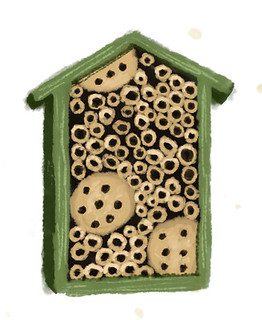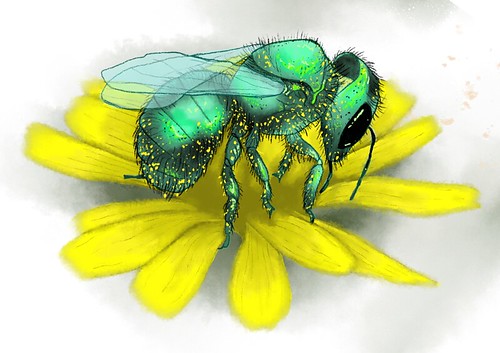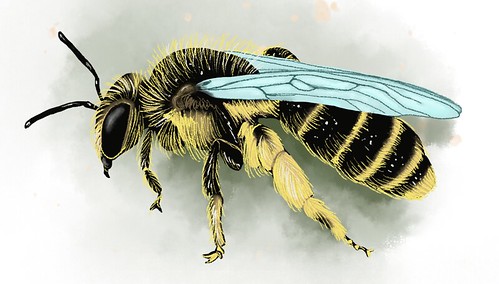Illustrations by Katie McElroy
Download Native Bees of Texas PDF
There are at least 1100 native bee species in Texas, possibly up to 1500.
They are the primary pollinators of native plants.
Most are solitary and do not defend their nests, therefore pose little risk of stings.
Support native bee populations in your garden by:
- Planting a variety of native wildflowers.
- Leave some areas free of mulch for ground nesting bees.
- Purchase or make a bee house for dead wood nesting bees.
Bumble Bees
Bombus spp.
- One of the few social native bees.
- Generalist pollinators, visit many different species of plants.
- Perform “buzz pollination” by vibrating their wings to extract pollen.
- Colonies are much smaller than honeybee hives.
- Different species build nests either in the ground or in grass or trees.
Leaf-Cutter Bees
Megachile spp.
- Cuts circular portions of leaves to use to build nest cells.
- Some use plant resin instead of leaves.
- Genus contains the world’s largest bee, Megachile pluto.
Large Carpenter Bees
Xylocopa spp.
- Burrow into wood to create nest cells.
- Commonly mistaken for bumblebees.
Mason Bees
Osmia spp.
- Nest in existing small cavities; do not excavate their own.
- Nesting material may be mud, grit, chewed plant tissue, etc..
Digger Bees
Anthophora spp.
- Nearly all species nest in soil.
- Wings appear disproportionately short compared to other bees.
Long-Horned Bees
Melissodes spp.
- Nearly all species nest in soil, most in flat ground but some in exposed banks.
- Male antennae are characteristically long.
- A few species aggregate Into communities, but each individual works only for their own brood.
Sunflower Bees
Svastra spp.
- Another type of long-horned bee.
- Offspring require pollen from the sunflower family (Astericide).
Sweat Bees
Agapostemon spp., Lasioglossum spp., Halictus spp.
- So-named due to their attraction to human sweat; they use the salt for nutrition.
- Some genera are metallic, some are fuzzy with stripes.
- Some species aggregate, but work only for their own brood.
- Females are usually entirely metallic blue/green, but sometimes have stripes on the abdomen.
Polyester Bees
Colletes spp.
- Secrete a waterproof, cellophane-like substance to line their brood cells.
- Nest in the ground, a few species live in large aggregations.












